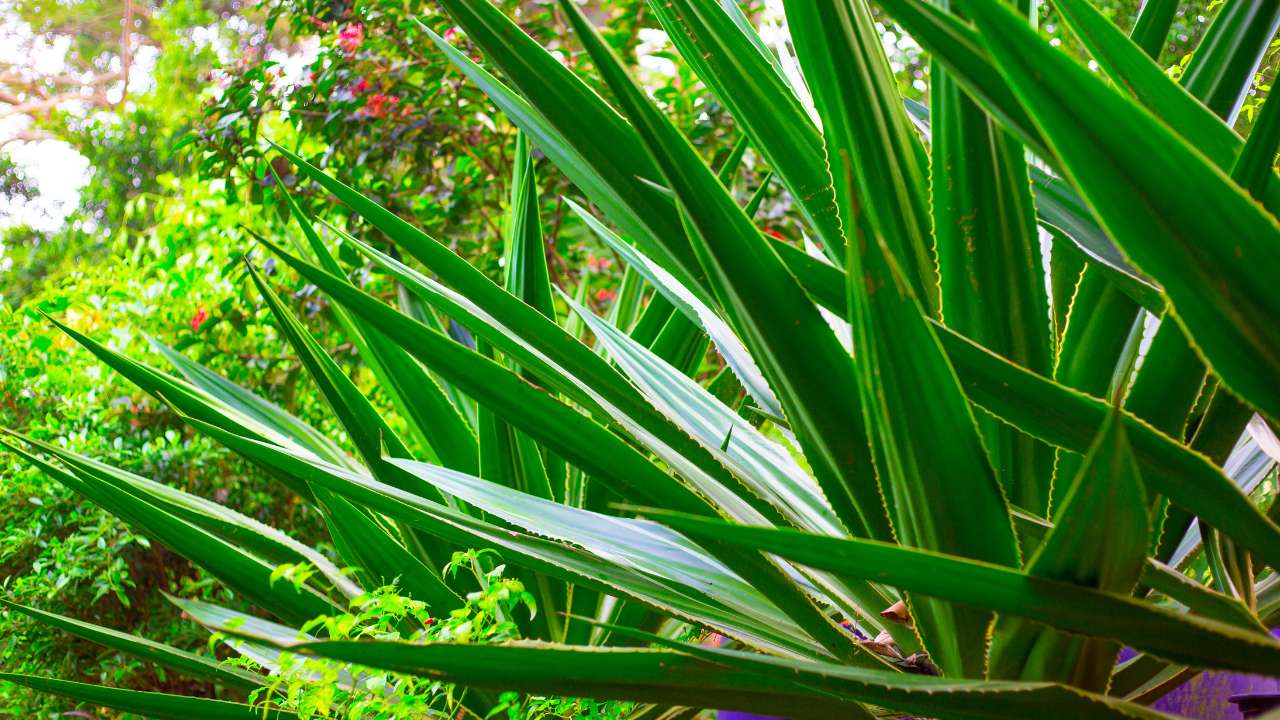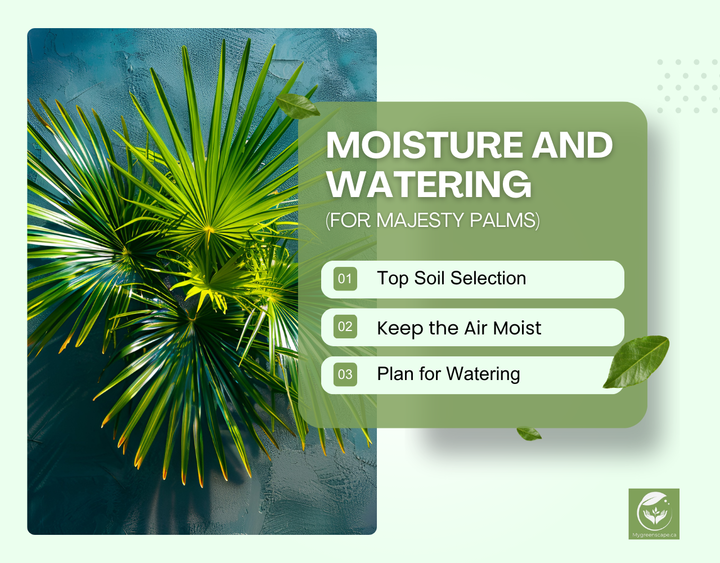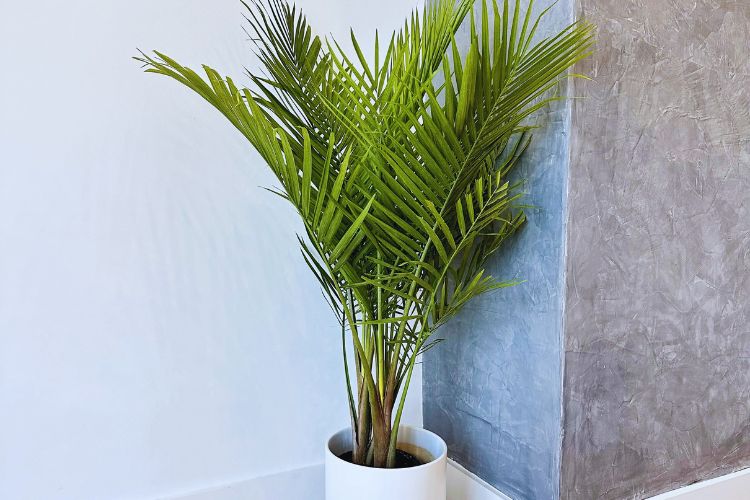
The Majesty Palm (Ravenea rivularis) is a tall plant with green leaves. It is a popular houseplant. This guide will help you take care of it. You will learn about the right light, soil, and water. We will also talk about how to keep the air moist for your plant. Plus, We’ll also talk about keeping the air moist for your plant. We’ll give tips on feeding the plant and keeping it healthy. You’ll learn simple ways to stop pests and diseases from harming your Majesty Palm.
| Attribute | Details |
|---|---|
| Common Name | Majesty Palm |
| Scientific Name | Ravenea rivularis |
| Native Region | Madagascar |
| Growth Habit | Upright with arching leaves |
| Height | Up to 10-20 feet in landscapes, 3-10 feet indoors |
| Light Requirements | Bright, indirect light |
| Common Pests/Diseases | Spider mites, mealybugs |
| Uses | Ornamental in gardens and as a potted plant |
A. Quick Care overview :
| Attribute | Care Instructions |
| Light | Bright, indirect light is best. Avoid direct sunlight, which can scorch the leaves. |
| Watering |
Keep soil consistently moist but not soggy. Water when the top inch of soil feels dry. Ensure good drainage. Reduce watering in winter.
|
| Soil |
Well-draining potting mix. A blend of potting soil, peat moss, and perlite or sand works well.
|
| Temperature |
Prefers temperatures between 65-75°F (18-24°C). Avoid placing near drafts or heat sources.
|
| Humidity |
Thrives in high humidity. Mist the leaves regularly, use a humidity tray, or place a humidifier nearby.
|
| Fertilizing |
Feed with a balanced, water-soluble fertilizer diluted to half strength every 2-4 weeks during the growing season (spring 1 to early fall). Do not fertilize in winter.
|
| Pruning | Remove yellow or brown fronds at the base. Avoid excessive pruning. |
| Repotting |
Repot every 2-3 years or when the plant becomes root-bound. Choose a pot with drainage holes that is slightly larger than the current one.
|
| Propagation |
Can be propagated by seed, though it's a slow process. Propagation by offsets (pups) is possible but less common.
|
| Common Pests | Spider mites, mealybugs, scale, and fungus gnats. |
| Pest Control |
Inspect regularly. Treat with insecticidal soap, neem oil, or a strong stream of water to dislodge pests. For fungus gnats, improve drainage and avoid overwatering.
|
| Toxicity | Non-toxic to pets and humans. |
| Special Notes | - Rotate the plant periodically for even growth. - Use rainwater or distilled water if possible to prevent salt buildup. - If leaves yellow rapidly, check for over-fertilization or poor drainage. |
B. Minimum Necessities For Majesty Palm Growth

Optimal Ambiance Lighting
Direct, indirect light is ideal for the Majesty Palm. Even though it thrives in partial shade, this pet-friendly plant still needs regular exposure to light to prevent leaf scorching. Locating it close to a window, where light may be softly diffused by a sheer drape, is perfect.
Where to Put Your Plant
If you want your Majesty Palm plant to get enough light, put it somewhere bright, preferably near a window that faces north or east. To supplement low levels of natural light, grow lights can be used. If you want your plant to grow evenly and on all sides, you should turn it every so often.
C. Top Soil Options for Majesty Palm
The ideal soil for a Majesty Palm tree drains well yet still holds moisture. An appropriate mixture would be potting soil, peat, and either sand or perlite. By achieving a balance between water retention and drainage, this mixture creates a steady environment for the roots.
D. Manage Moisture and Watering Effectively

Plan for Watering
When you feel the top inch of soil become dry, water your Majesty Palm. It can require watering once weekly in a stronger light. Twice every two weeks could be enough in dim light. Seasonality and the plant's natural habitat should be considered while determining the frequency. Never let water pool on top; it must always drain.
Keeping the Air Moist
Humidity is ideal for Majesty Palm plant care since it mimics their natural tropical habitat. Put a humidity tray under the plant or turn on the humidifier in the room to raise the humidity level. Additionally, it can be helpful to mist the leaves frequently, particularly in the dry winter months.
Part 3: Pruning Majesty Palms for Healthy Growth and Shape
Majesty palms maintenance does not require strict pruning. Prune the houseplant occasionally to improve its health and aesthetics. Here is some information to help you keep your plants healthy.
Ravenea species do not require season-specific pruning. Clean the damaged and yellowed fronds only when necessary.
- ➜ Cut the fronds near the base without putting cuts on the trunk.
- ➜ Avoid pulling out too many leaves at once. This can decrease photosynthesis and put plants under stress.
- ➜ Do not prune during pest infestation, drought, or low-plant growth periods.
- ➜ If there is continued yellowing of leaves in a short period, address issues like humidity and water control.
- ➜ Trim or cut only the dried areas that have turned brown/yellow.
Majesty palm tree care is very easy. However, they are also very bothered by their looks, so avoid unnecessary pruning. Only cut out fronds every so often.
Part 4: Propagating Majesty Palms: Tips and Techniques

Now, if you are ready to take up the challenge of harvesting more majesty plants, here is how to do it.
There are two ways to propagate this tough bean: the seed method or harvesting the shoots. Seeding is common and easier to practice, while the latter is rarely done. Below is a complete guide for each method.
1. Seeding New Majesty Palms
Seeding? Does it seem daunting already? Majesty plants seed only when mature. This can take a long time, but propagating with seeds isn't impossible.
- First, pick out seeds from your majesty palm or get them from a reliable nursery. Old seeds can go dormant. Ensure your seeds are viable and soak them in lukewarm water for 1-2 days.
- Dig and insert the seed up to 1 inch into a well-draining soil mixture. Keep the soil moist but not waterlogged.
- Wrap cling film or a plastic bag around the plant to maintain its high moisture content. Keep the pot in indirect light at around 75 degrees.
Your seeds may not sprout for three weeks or over a month. Maintain the requirements and do yoga until the seed germinates!
2. Propagating the Plants with Offsets
Offsets, shoots, or palm pups are the small new buds at the base of the plant. Instead of seeding, pot an entire shoot to grow a majesty palm. However, majesty palms rarely grow buds, especially indoors.
When repotting, look for small offshoots and buds with roots. Place the palm pup in a new pot with a well-draining soil mixture. Cover the plant with plastic wrap and provide similar conditions as the parent palm.
Let your bud strive and thrive to grow into a bigger majesty palm. Learning how to propagate and multiply your houseplants will help keep them healthy and thriving.
Directions for Planting and Repotted Plants
To avoid water gathering at the base of the pot, be sure to use a container with drainage holes while potting. To make it easier for water to drain, add gravel or some like material to the base. Arrange the palm such that its root ball is slightly below the pot's rim, and then fill it with the soil mixture. Rinse well with water following potting.
Part 5: Comparison for Majesty Palm and related palm varieties
| Feature | Majesty Palm | Areca Palm | Parlor Palm | Kentia Palm |
|---|---|---|---|---|
| Botanical Name | Ravenea rivularis | Dypsis lutescens | Chamaedorea elegans | Howea forsteriana |
| Common Names | Majesty Palm, Ravenea Palm | Butterfly Palm, Golden Cane Palm | Parlor Palm, Neanthe Bella Palm | Kentia Palm, Thatch Palm |
| Native Area | Madagascar | Madagascar | Central America | Lord Howe Island, Australia |
| Growth Rate | Moderate | Moderate to Fast | Slow | Slow |
| Mature Height (Indoor) | 8–10 ft | 6–8 ft | 4–6 ft | 5–10 ft |
| Light Requirement | Bright, indirect light | Bright, indirect light | Low to moderate light | Bright, indirect light |
| Water Requirement | Keep soil moist but not soggy | Prefers consistently moist soil | Allow topsoil to dry between watering | Water when topsoil dries |
| Humidity Preference | High (thrives with misting) | Moderate to high | Moderate | High |
Part 6: Tips for Fertilization for Majesty Palm Growth
Tip 1: Timing of Fertilization
During the spring to early fall growing season, fertilize your Majesty Palm. Fertilizing plants in the winter is a bad idea because their growth rate is so low.
Tip 2: Balanced Fertilizer
Opt for a balanced fertilizer that dissolves in water. To prevent overfeeding, mix it at half the strength advised. Fortnightly to biweekly, sprinkle the fertilizer. For optimal nutrient distribution and to avoid root burn, water the plant both before and after fertilization.
Tip 3: Use Balanced Fertilizer Ratios
Go with a well-rounded combination like 10-10-10 or 20-20-20. By maintaining these proportions, you may be certain that your plant will receive an adequate supply of the growth-promoting nutrients nitrogen, phosphorus, and potassium.
Pro Tips:
- During winter, reduce watering frequency and move your plant away from drafty windows or doors to protect it from cold stress.
- Rotate your Majesty Palm 90 degrees every week to ensure even growth and prevent leaning towards one side.
- If leaves are yellowing rapidly, check for signs of overfertilization. Flush the soil with water to remove excess salts.
- Use rainwater or distilled water for your Majesty Palm to avoid salt buildup in the soil, which can damage the plant's roots over time.
- Insert a wooden skewer into the soil and check for moisture before watering. If it comes out clean and dry, it's time to water.
Part 7: Common Pest Infestations: Identification, Solutions, and Prevention

Majesty Palms plant care includes bug infestation as a top factor. They are prone to attack by many common house plant bugs. Undernourished plants are more susceptible to damage. Here is what common pest infestation looks like for majesty palms.
A. Specific Pest Identification and Treatment
1. Spider Mites
This is the most popular pest that threatens almost all houseplants.
Identification: Spider mites are tiny and often create fine webbing on the fronds. You might also notice yellowing leaves that become crusty and brittle.
Causes: It attacks when Majesty plants are exposed to drought periods or low humidity.
Treatment:
- ➜ Weekly neem sprays keep away spider mites.
- ➜ Maintain adequate humidity and moisture.
- ➜ Use a high-pressure water shower to remove all the mites.
- ➜ Clean leaves from all the areas, especially the base.
2. Fungus Gnats
This fungus specifically affects the roots of majesty palms.
Identification: If you see black flies roaming around the roots, the fungus has already started to build up. They leave larvae in the soil mixture that decays the roots.
Cause: This happens when the pot is overwatered, or the soil mixture is wrong.
Treatment:
- ➜ Use a well-draining pot for majesty palms.
- ➜ No stagnant water in the pot.
- ➜ Use well-draining soil and keep it moist.
- ➜ Use sticky traps to catch the large gnats.
- ➜ Add Bacillus thuringiensis to kill the larvae in the roots.
Less often, you may also find Aphids and mealy bugs hovering over the plant. A timely insecticide spray and good environment check can keep them all away!
B. Common Problems and Solutions (Troubleshooting)
|
Problem |
Possible Causes |
Solutions |
|
Decaying or Yellowing Grass/Leaves |
Overwatering, underwatering, inadequate drainage |
Check soil moisture. Adjust watering schedule. Ensure the container has drainage holes. |
|
Decreased or Stunted Growth |
Lack of nutrients, insufficient light |
Place the plant in bright, indirect light. Fertilize regularly with a balanced fertilizer during the growing season. |
|
General Care Advice for Healthy Plants |
Pests, incorrect humidity levels, accumulation of dead/dying foliage |
Regularly check for pests. Ensure proper humidity. Remove any yellowing or dead leaves to encourage healthy growth. |
C. Prevention: Keeping Your Majesty Palm Healthy
A. General Care Practices
- Provide adequate watering, bright indirect light, and sufficient humidity.
- Regularly dust or wipe down the leaves with a damp cloth to remove dust and deter pests.
B. Regular Inspection
- Frequently check your palm for any signs of pests or illness. Early detection is key to successful treatment.
C. Treatment (If Needed)
- If you do find pests, neem oil or insecticidal soap are generally safe and effective treatments.
- Always follow the product's instructions carefully and repeat applications as needed.
In summary
Indoors, a Majesty Palm requires regular watering, soil that drains well, and indirect light. It is essential to fertilize the plant frequently throughout the growing season and to keep the humidity levels high. Always be on the lookout for pests and act swiftly to remedy any problems, such as leaves turning yellow or growth being hindered. You can bring the beauty of a healthy Majesty Palm outdoors into your house by following these guidelines. If you want to see one flourish, try growing this air-purifying plant using these easy majesty palm care outdoor maintenance tips.
Frequently Asked Questions
Do Majesty Palms Need Direct Sunlight?
No. Ideally, majesty palms prefer indirect sunlight but can be exposed to bright sunlight. Direct sunlight can burn off their fronds and dry the leaves. When caring for majesty palms indoors, ensure the placement of pots away from windows or plant lamps.
What does an unhealthy Majesty Palm look like?
An unhealthy majesty palm will have most of its fronds turned yellow or brown. The leaves will become straighter and look dull. The soil can be dry and cracky, and pests can hover over the plant. Bug infestation can also cause webbing or the presence of small shells on the leaves.
What is the best plant food for majesty palms?
When caring for a majesty palm, maintain adequate water requirements and keep the soil moist at all times. Ensure indirect, bright sunlight and a temperature of around 65-75 degrees Celsius. Besides, feed your plant fertilizers rich in manganese, potassium, and nitrogen.
Do majesty palms like to be root-bound?
Root-bounding majesty palms can shunt their growth and eventually cause death. The plant doesn't absorb adequate water and has limited nutrition uptake.



